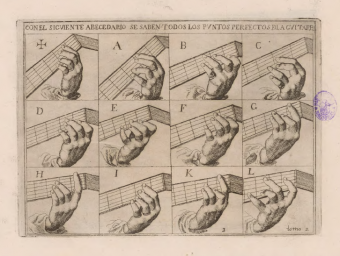 Gaspar Sanz, « Laberinto en la guitarra que enseña un son por 12 partes », tiré de « Instrucción de música sobre la guitarra española (…) », Saragosse, 1674, Biblioteca nacional, Madrid
Gaspar Sanz, « Laberinto en la guitarra que enseña un son por 12 partes », tiré de « Instrucción de música sobre la guitarra española (…) », Saragosse, 1674, Biblioteca nacional, Madrid
1.2.2014, 16h
De los castillos y calles de España
Hopkinson Smith, guitare baroque
Pièces de Gaspar Sanz, Francisco Guerau et Antonio de Santa Cruz
Hopkinson Smith, musicien d’origine new-yorkaise, est reconnu internationalement pour ses interprétations du répertoire du luth renaissance et du luth baroque ainsi que du théorbe, de la vihuela et de la guitare baroque. Il a été membre fondateur de l’ensemble Hespèrion XX. Il est professeur à la Schola Cantorum Basiliensis à Bâle.
Programme
Gaspar Sanz (1640-1710)
(Pièces tirées de Instrucción de música sobre la guitarra española (…), Saragosse, 1674, et Libro segundo, de cifras sobre la guitarra española (…), Saragosse, 1675)
Trois thèmes espagnols
- Pavanas con Partidas al Aire Español
- Folías
- Zarabanda
L’Europe en miniature
- La Esfachata de Nápoles
- La Miñona de Cataluña
- La Coquina Francesa
- Lantururú
- Canción
- Tarantela
Francisco Guerau (1649- c. 1720)
(Pièces tirées de Poema Harmónico, Madrid, 1694)
- Passacalles del primer tono
- Canarios
Antonio de Santa Cruz (c. 1650- c. 1710)
- Jácaras
Gaspar Sanz (1640-1710)
- Preludio o Capricho Arpeado
- Marizápalos
- Jiga
- Passacalles del segundo tono
- Canarios
Guitare baroque à cinq chœurs construite par Joel van Lennep, New Hampshire
Presentation text by Hopkinson Smith: Spanish Guitar Music of the 17th Century
The guitar has been associated with Spanish popular culture since before the Renaissance and its importance in traditional music has remained unchanged up to our own times. But from the beginning, there existed as well a highly developed and refined culture of composition where the guitar was an equal to other instruments for which complex voice-leading and elaborate variation sets were conceived. This program should demonstrate the full spectrum of inspiration for the guitar in 17th century Spain from the strummed music of the street to more extended forms constructed along elaborate architectural lines for the initiated from court circles.
Of the latter, the high point of the program will be the Passacalles del primer tono by Francisco Guerau (1649- c. 1720). With a clear meter, first in duple then in triple time, and with elaborate counterpoint within the four-measure variation context, this piece builds in intensity throughout its extended form. This compositional style contrasts sharply with a piece such as Gaspar Sanz’s Tarantela, a Spanish version of the Italian dance played only with the driving rhythm of a series of cleverly devised strummed chords. And in between these two extremes we have an entire series of popular-inspired melodies, regional character pieces and lyrical variations on traditional themes.
The title of the book by Gaspar Sanz (1640-1710), Instrucción de música sobre la guitarra española (Saragossa, 1674), presents it as a guitar method, but it is above all an anthology with every possible musical form that the guitar of the time could play, from evocative melodies set with simple charm to more elaborate freely-composed fantasy-like original compositions.
Francisco Guerau’s Poema Harmónico (Madrid, 1694), is a collection of variation sets with some of the most sophisticated writing for the guitar from the entire baroque era. Well aware of contemporary styles in France and Italy, Francisco Guerau created works of extraordinary variety and often profound inspiration.
Of special interest is the tuning of the 5-course guitar in 17th century Spain. Following the advice of Gaspar Sanz, the 4th and 5th course are tuned an octave higher than one would encounter on the modern guitar with the result that the lowest pitch is the 3rd course. This treble-oriented world of sound gives a unique poetic aura which in its best moments creates a magic of its own. (HS)


